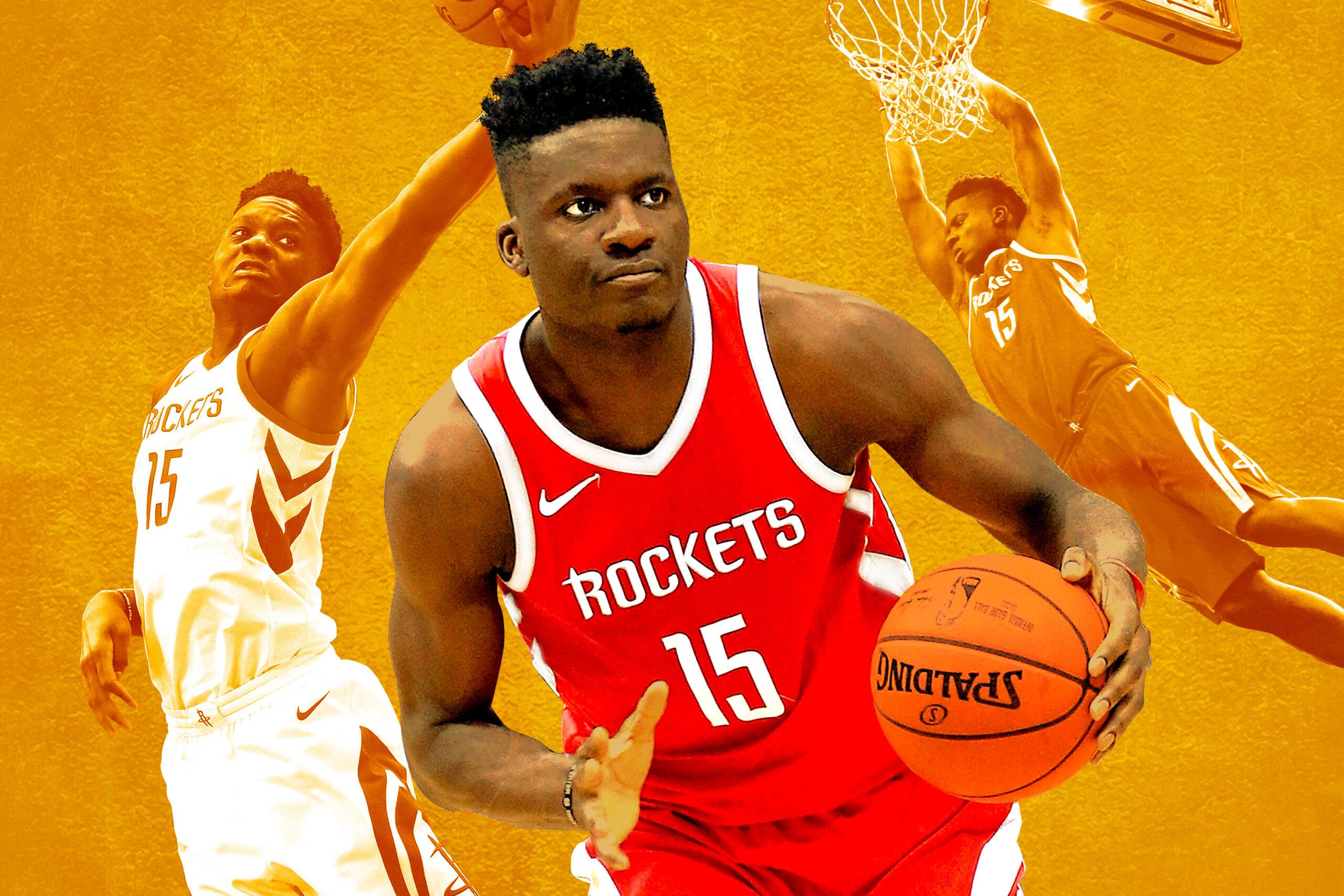
Twenty and 10 is a standard for big men in the NBA, one of those random-but-for-humans-having-10-fingers statistical benchmarks that survives the game’s evolution. Every sport has those benchmarks — hitting .300, scoring 50 goals, rushing for 1,000 yards — even though they’re easier to reach in some eras than others. But say “20 and 10” and you know what kind of player we’re talking about.
On Sunday night, in Game 1 of Houston’s first-round series against the Minnesota Timberwolves, Rockets center Clint Capela pulled down 20 and 10 in the first half, in 17 minutes of playing time. Capela’s extraordinary first half got a little lost when James Harden’s 44-point night saved Houston from dropping Game 1, and understandably so. No other Rockets perimeter player shot better than 40 percent from the floor, and all non-Harden Rockets combined to go 3-for-25 from 3-point range. Capela was the only member of Houston’s supporting cast who had a big night.
But that first-half 20 and 10 is important for two reasons beyond Game 1. First, how Capela got there is evidence that he’s an ideal center for the modern NBA, particularly on a small-ball team like the Rockets. Second, it’s another indication that we need to reevaluate whether Capela is, in fact, a supporting player, or whether his name belongs on the marquee.
You can’t win in the NBA by sticking a big, slow guy at center anymore. I don’t know whether you’ve heard — it’s been in the news. The game’s too fast, and modern pick-and-roll offenses eat concrete-footed bigs alive. A lucky few teams have stumbled into 7-footers with 3-point range, a good passing eye, and enough quickness to at least stay in front of guards. Others abandon the center for a lineup made up entirely of shooters, placing someone who would’ve been a small forward 10 years ago in the post. Capela’s Rockets frequently give center minutes to P.J. Tucker, a 36 percent career 3-point shooter who is just 6-foot-6 and shaped like a traffic bollard.
The third option is to find a center who’s big and long enough to rebound and to protect the rim on the defensive end, but quick enough not to get his lunch money stolen when he has to switch on a screen, and able to keep up with his guards when they run the floor.
These centers dine out on the pick-and-roll in the half court by setting a screen and crashing to the basket, a tactic idealized in the modern game by Chris Paul and DeAndre Jordan on the Los Angeles Clippers. The point guard has space to operate, and the center gets to take most of his shots at the rim, either uncontested or against a moving defender. Paul and Jordan played together for six seasons — in five of them, Jordan led the league in both field goal percentage and effective field goal percentage.
With Paul now on the Rockets, Capela broke Jordan’s hold on the field goal and effective field goal percentage titles in 2017–18.
“He’s really the X factor,” Paul said of Capela after Game 1, “because the threat of him at the rim is why I get my floaters, why I get my midrange.”
But in Game 1, it was Harden on the ball for most of Capela’s highlights. You can see Paul and Jordan in the Harden-Capela pick-and-roll, but it looks like the next step in an evolution, like a new smartphone or that year in the ’90s when they decided all cars should have curved bodies. Harden is bigger and stronger than Paul, with a longer shooting range. Capela, at 6-foot-10 and 240 pounds, isn’t as big as Jordan, but he’s fast and explosive, with remarkable hands for a big guy. Harden is able to toss anything from waist-high laterals to high-arcing lobs, and Capela sucks it up like he’s coated his palms with stickum.
“It’s something that I’ve always had naturally,” Capela said of his magnetic mitts. “I don’t think about it very much — it’s never been difficult for me to catch the ball, so I’ve never really worked on it.”
In four years together, Harden and Capela have developed such an understanding that it often feels like Capela is operating as an extension of the Rockets shooting guard, less another player than an extra set of limbs.
Harden exerts a gravitational force as he drives to the net, creating vast swaths of open space as defenders fall back to keep him from getting to the hoop — which is tough enough on its own. Capela’s quickness and understanding with Harden allow him to exploit that space, while his length and hands allow him to track down whatever Harden throws at him. As good a passer as Harden is, those passes are often thrown off-balance and through traffic, so they’re not always pretty.
Capela has improved across the board in each of his four seasons in the NBA, but particularly in the past two. When Mike D’Antoni took over as Rockets head coach, in 2016–17, Capela played five more minutes a game than in the previous season, and he demolished his previous career highs in scoring and shooting percentage. In 2017–18, with Paul on the team, Capela added a block and three rebounds per 100 possessions, saw his already-elite field goal percentage rise, and finished 10th in the league in total rebounds per game and in the top five in offensive rebounds and blocks.
Capela sees his evolution as a matter of getting the opportunity.
“I don’t think I’m doing that much different,” Capela said. “I’ve just been able to be more consistent, more aggressive, and they’ve pushed me to do that.”
But he has evolved. Capela joined the NBA in 2014, a draft year whose lottery was dominated by wings and forwards, while the Warriors were perfecting a brand of small ball that would win them the title that season. The top center in the draft, Joel Embiid, went third overall to the Sixers, while Capela was one of a set of European projects, along with Jusuf Nurkic and Nikola Jokic, who fell outside the lottery. A few analysts, like ESPN’s Kevin Pelton, looked at Capela’s field goal percentage and block numbers and saw the potential for him to turn into exactly what he’s become. So did the Rockets, who snapped Capela up with the 25th pick. The then-20-year-old spent most of his rookie year in what was then the D-League; he played just 90 NBA minutes and missed 19 of his 23 free throws. But over the past three seasons, Capela has made the most of his opportunities as the Rockets have gotten faster and competing bigs Dwight Howard, Montrezl Harrell, and Nene have either left town or fallen into the background.
“The sky’s the limit for Clint. It’s been perfect,” Paul said. “It’s unbelievable the way we get a chance to talk and communicate. I know sometimes he gets tired of hearing me and James telling him to set the screen this way or roll this way, but it’s crazy — y’all know the record when we all play together, and I’ll tell you, it’s not because of me and James.”
In case you didn’t know Houston’s record when Capela, Paul, and Harden all play, it’s 42–3 in the regular season, and now 2–0 in the playoffs. Harden is the presumptive MVP and Houston’s longtime franchise player, while Paul is bound for the Hall of Fame. Those two take up a lot of oxygen in the Houston basketball landscape, but Capela is closer to them in profile and importance than he is to the rotating cast of role players from which he emerged.
“He was sitting at the kids’ table at the wedding for a long time,” D’Antoni said after Game 1. “Now he’s giving toasts and stuff. He’s up with the guys and they have confidence in him — he’s matured a lot, especially in the eyes of the other players.”
Despite being the perfect big for Harden and Paul, Capela’s game has limitations that will prevent him from reaching the superstar status Paul predicted for him. Capela’s potential as a scorer is pretty much limited to dunks and layups — in four NBA seasons he’s attempted only three desperation heaves from beyond the arc — and he’s improved his free throw shooting to 56 percent this season, which is damning with faint praise.
But Jordan has those limitations, too, and he made three All-NBA teams and signed a four-year, $88 million contract in 2015 as one of the league’s most sought-after free agents. D’Antoni predicted a similar payday for Capela, joking that his 23-year-old center is underappreciated now, but that won’t be the case when he hits restricted free agency this summer.
Capela carries himself with such a happy-go-lucky attitude that it makes you wonder whether he doesn’t realize his importance. Harden and Paul are more guarded, but Capela is easy with the press and up for anything when it comes to the team’s marketing staff. Last year, he starred in “A Cappella With Capela,” which is the best video board segment in the history of professional sports.
Capela might never be the best player on a championship team, but he’s already a cult favorite and the third corner to the Rockets’ Freudian Triad, the id to Harden’s ego and Paul’s superego. If he’s still a complementary player, he’s a crucial one, well deserving of his spot at the grown-ups’ table.
